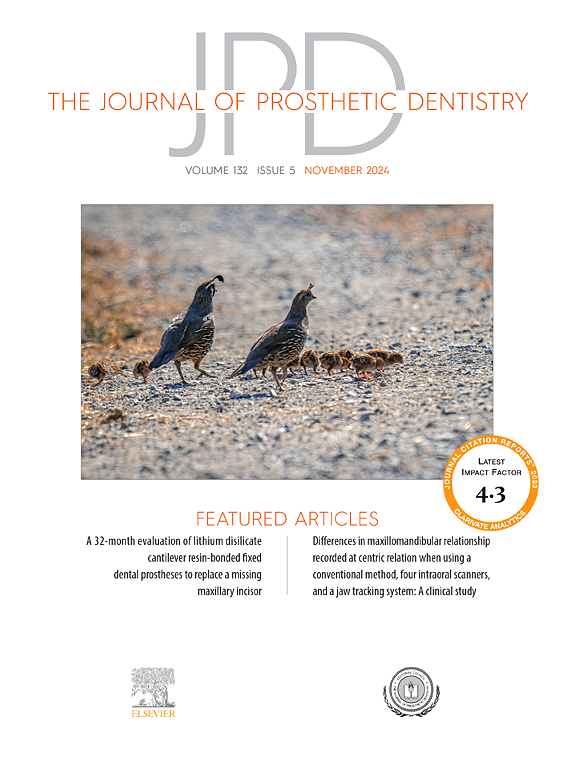预处理策略对3D打印复合树脂与牙本质粘结强度的影响。
IF 4.8
2区 医学
Q1 DENTISTRY, ORAL SURGERY & MEDICINE
引用次数: 0
摘要
问题说明:对于影响牙科增材制造材料粘结强度的因素知之甚少。不同的预处理策略对3D打印复合树脂粘结强度的影响,表明其与牙本质的最终胶结很少被研究。目的:通过不同的预处理方案,评价两种3D打印确定固定修复材料与牙本质的粘接强度。材料与方法:3D打印复合树脂棒(2×2×10 mm, n=20/组),3D打印3Delta冠和saremco打印CROWNTEC。一半的棒是空气颗粒磨损(APA),另一半棒是未经处理的。所有棒都用3种粘合剂(adese Universal, Heliobond, Monobond Plus)中的一种进行化学处理。从牛牙上切下牙本质棒(2×2×5 mm),用adese Universal进行预处理,用Variolink aesthetic LC与复合树脂棒粘合。在进行拉伸粘结强度(TBS)测试和破坏模式评估之前,对试件进行了10000次热循环。用激光扫描显微镜和拉曼光谱检测了表面粗糙度(SR)和转换度(DC)。数据采用1-、2-和3-way方差分析(anova)和Weibull分析(α= 0.05)进行统计学分析。结果:TBS值为6.57 ~ 10.58 MPa,各组间差异无统计学意义(P < 0.05)。所有组均表现出相当的威布尔模量和主要的粘接剂失效。结论:无论何种3D打印材料,APA均使SR升高,DC在70%左右。不同的机械和化学预处理对TBS的影响相对较小。本文章由计算机程序翻译,如有差异,请以英文原文为准。
Influence of pretreatment strategies on the tensile bond strength of 3D printed composite resins for definitive cementation to dentin
Statement of problem
Little is known about factors influencing the bond strength of additively manufactured materials in dentistry. The impact of diverse pretreatment strategies on the bond strength of 3-dimensionally (3D) printed composite resins indicated for definitive cementation to dentin has scarcely been investigated.
Purpose
The aim of this study was to evaluate the adhesive bond strength of two 3D printed definitive fixed restoration materials to dentin by using different pretreatment protocols.
Material and methods
Composite resin rods (2×2×10 mm, n=20/group) were 3D printed with 3Delta Crown and saremco print CROWNTEC. Half of the rods were airborne-particle abraded (APA), the other half of the rods were untreated. All rods were chemically conditioned with 1 of 3 adhesives (Adhese Universal, Heliobond, Monobond Plus). Dentin rods (2×2×5 mm) were cut from bovine teeth, pretreated with Adhese Universal, and bonded to the composite resin rods with Variolink Esthetic LC. The specimens were thermocycled (10 000 cycles) before testing for tensile bond strength (TBS) and the assessment of the failure mode. Surface roughness (SR) and degree of conversion (DC) were examined with laser scanning microscopy and Raman spectroscopy. Data were statistically analyzed with 1-, 2-, and 3-way analyses of variance (ANOVAs) and Weibull analysis (α=.05).
Results
TBS values ranged from 6.57 to 10.58 MPa, without significant differences among the groups (P>.05). All groups demonstrated a comparable Weibull modulus and predominant adhesive failure. SR increased significantly (P<.05) upon APA, and the DC ranged from 70.1% to 71.9%.
Conclusions
Regardless of the 3D printable material, SR was increased by APA, and the DC was around 70%. Different mechanical and chemical pretreatments appear to exert relatively little influence on TBS.
求助全文
通过发布文献求助,成功后即可免费获取论文全文。
去求助
来源期刊

Journal of Prosthetic Dentistry
医学-牙科与口腔外科
CiteScore
7.00
自引率
13.00%
发文量
599
审稿时长
69 days
期刊介绍:
The Journal of Prosthetic Dentistry is the leading professional journal devoted exclusively to prosthetic and restorative dentistry. The Journal is the official publication for 24 leading U.S. international prosthodontic organizations. The monthly publication features timely, original peer-reviewed articles on the newest techniques, dental materials, and research findings. The Journal serves prosthodontists and dentists in advanced practice, and features color photos that illustrate many step-by-step procedures. The Journal of Prosthetic Dentistry is included in Index Medicus and CINAHL.
 求助内容:
求助内容: 应助结果提醒方式:
应助结果提醒方式:


